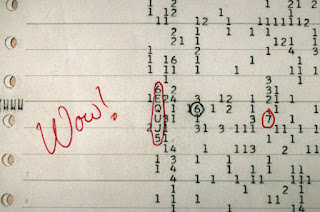Newton
In 1666 the 'great plague' epidemic brought havoc to London and as a result effective 'lockdown' restrictions were introduced. In greater London, the University of Cambridge closed as a precaution. However, an infamous student of the university at the time returned to his home in Lincolnshire and continued his study. His name was Isaac Newton and during this epidemic he was about to make scientific history...
During 1666 Newton began to work on ground breaking (at the time) science and mathematics. These were gravitation, calculus and optics:
 |
| Figure 1: Newtons work on gravitation started in 1666, a) planetary gravitation and b) local gravitation. |
Newton pondered the motion of the moon around the Earth and believed some invisible force was responsible. The story goes that whilst sitting underneath a tree an apple fell and bounced of his head. This got Newton thinking, perhaps the same force operates on both small local levels and large planetary levels? Thus the very simple equation was derived. Here the gravitational force (F) is described as the attraction between two objects with mass (M1 and M2) divided by their distance (r) separation squared. This tells us that large objects experience a large gravitation force and at increasing distances a smaller gravitational force. At the time this was highly intuitive as there was no reason to suggest that the same force acts upon small and large objects, arguably the first ever force unification.
In order to study the free fall of objects under the force of gravitation, Newton out of necessity needed to develop a new kind of mathematics, this is called calculus:
 |
| Figure 2: As a necessity Newton developed calculus in 1666, a) acceleration due to free fall (figure 1b) and b) applying calculus yields acceleration due to gravity. Acceleration due to free fall is quadratic in nature (figure 1b and 2a), the larger the distance travelled in free fall the greater the gravitational force. Newton wanted to know the exact speed of the object (M2) at any point along the coordinate (r) as opposed to calculating a total average. In this instance applying calculus to this quadratic curve yields a straight line, this is achieved by taking finite derivatives (dr/dt) of various points along figure 2a, these derivative are essentially speed of the object. Figure 2b shows plotting these derivatives against time yields a straight line, with the gradient being acceleration due to gravity (g). Currently, our accepted value of g (in a vacuum) is 9.8m/s regardless of weight. Finally, in 1666 Newton purchased a glass prism and studied the properties of light, this is known as optics: |
 |
| Figure 3: Newton was also fascinated by light and in 1666 began his work on optics. |
At the time it was commonly accepted that light was one colour and colour was merely a property of the material it had reflected from. Newton was not convinced and set up an experiment at home. Here he positioned a glass prism between a natural light source and a surface. The light source was focused through a tiny gap on a wall surface at home. He observed that light diffracted upon contact with the prism and produced a spectrum of colours on the adjacent wall. In further experimentation between 1670-1672, Newton was able to demonstrate that light could be recombined or partially recombined using a second prism. Thus proving that colour was a property of light and not the reflective material.
Post epidemic, Newton (with a lot of patience) published his work on gravitation in 1687 in a book called "Principia". His work on calculus was published earlier in 1671 in a book called "Fluxions" and his work on light in 1704 in a book called "Opticks".
Whilst all this work seems obvious to us now, at the time it was 'ground breaking'. But what I find most topical is that Newton humbly began this work during an epidemic, at home and without commodities that we take for granted today.
It does excite me that perhaps (at the time of writing this during a pandemic and lockdown) there is another Isaac Newton making such early observations to current physical problems. But needless to say and regardless of what your profession is, can't we all take inspiration from this?



Comments
Post a Comment